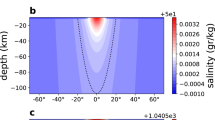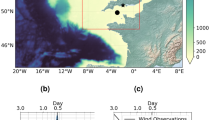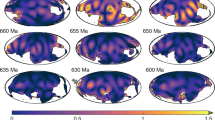Abstract
Data from recent space missions have added strong support for the idea that there are liquid oceans on several moons of the outer planets, with Jupiter's moon Europa having received the most attention1,2,3,4. But given the extremely cold surface temperatures and meagre radiogenic heat sources of these moons, it is still unclear how these oceans remain liquid. The prevailing conjecture is that these oceans are heated by tidal forces that flex the solid moon (rock plus ice) during its eccentric orbit, and that this heat entering the ocean does not rapidly escape because of the insulating layer of ice over the ocean surface. Here, however, I describe strong tidal dissipation (and heating) in the liquid oceans; I show that a subdominant and previously unconsidered tidal force due to obliquity (axial tilt of the moon with respect to its orbital plane) has the right form and frequency to resonantly excite large-amplitude Rossby waves in these oceans. In the specific case of Europa, the minimum kinetic energy of the flow associated with this resonance (7.3 × 1018 J) is two thousand times larger than that of the flow excited by the dominant tidal forces, and dissipation of this energy seems large enough to be a primary ocean heat source.
This is a preview of subscription content, access via your institution
Access options
Subscribe to this journal
Receive 51 print issues and online access
$199.00 per year
only $3.90 per issue
Buy this article
- Purchase on Springer Link
- Instant access to full article PDF
Prices may be subject to local taxes which are calculated during checkout


Similar content being viewed by others
References
Carr, M. H. et al. Evidence for a subsurface ocean on Europa. Nature 391, 363–365 (1998)
Kivelson, M. G. et al. Galileo magnetometer measurements: A stronger case for a subsurface ocean at Europa. Science 289, 1340–1343 (1981)
Stevenson, D. Europa’s ocean—the case strengthens. Science 289, 1305–1306 (2000)
Spohn, T. & Schubert, G. Oceans in the icy Galilean satellites of Jupiter? Icarus 161, 456–467 (2003)
Sagan, C. & Dermott, F. The tide in the seas of Titan. Nature 300, 731–733 (1982)
Sears, W. D. Tidal dissipation in oceans on Titan. Icarus 113, 39–56 (1995)
Moore, W. B. & Schubert, G. The tidal response of Europa. Icarus 147, 317–319 (2000)
Fabrycky, D. C., Johnson, E. T. & Goodman, J. Cassini states with dissipation: Why obliquity tides cannot inflate hot Jupiters. Astrophys. J. 665, 754–766 (2007)
Levrard, B. et al. Tidal dissipation within hot Jupiters: a new appraisal. Astron. Astrophys. 462, L5–L8 (2007)
Winn, J. N. & Holman, M. J. Obliquity tides on hot Jupiters. Astrophys. J. 628, L159–L162 (2005)
Wadhams, P. Attenuation of swell by sea ice. J. Geophys. Res. 78, 3552–3563 (1973)
Longuet-Higgins, M. The eigenfunctions of Laplace's tidal equations over a sphere. Phil. Trans. R. Soc. Lond. A. 262, 511–607 (1968)
Bills, B. G. Free and forced obliquities of the Galilean satellites of Jupiter. Icarus 175, 233–247 (2005)
Squyres, S. W., Reynolds, R. T., Cassen, P. M. & Peale, S. J. The evolution of Enceladus. Icarus 53, 319–331 (1983)
Ojakangas, G. W. & Stevenson, D. J. Episodic volcanism of tidally heated satellites with application to Io. Icarus 66, 9459–9470 (1986)
Egbert, G. D. & Ray, R. D. Estimates of M2 tidal energy dissipation from TOPEX/Poseidon altimeter data. J. Geophys. Res. 106, 22475–22502 (2001)
Jayne, S. R. & Laurent, L. C. S. Parameterizing tidal dissipation over rough topography. Geophys. Res. Lett. 28, 811–814 (2001)
Acknowledgements
K. Khurana provided helpful comments during the preparation of this manuscript. This work has been supported by the NASA Outer Planets Research program.
Author information
Authors and Affiliations
Corresponding author
PowerPoint slides
Rights and permissions
About this article
Cite this article
Tyler, R. Strong ocean tidal flow and heating on moons of the outer planets. Nature 456, 770–772 (2008). https://doi.org/10.1038/nature07571
Received:
Accepted:
Issue Date:
DOI: https://doi.org/10.1038/nature07571
This article is cited by
Long-Term Evolution of the Saturnian System
Space Science Reviews (2024)
Tidal transports from satellite observations of earth’s magnetic field
Scientific Reports (2023)
Dynamic Europa ocean shows transient Taylor columns and convection driven by ice melting and salinity
Nature Communications (2021)
Ice-Ocean Exchange Processes in the Jovian and Saturnian Satellites
Space Science Reviews (2020)
A magnetically driven equatorial jet in Europa’s ocean
Nature Astronomy (2019)
Comments
By submitting a comment you agree to abide by our Terms and Community Guidelines. If you find something abusive or that does not comply with our terms or guidelines please flag it as inappropriate.



